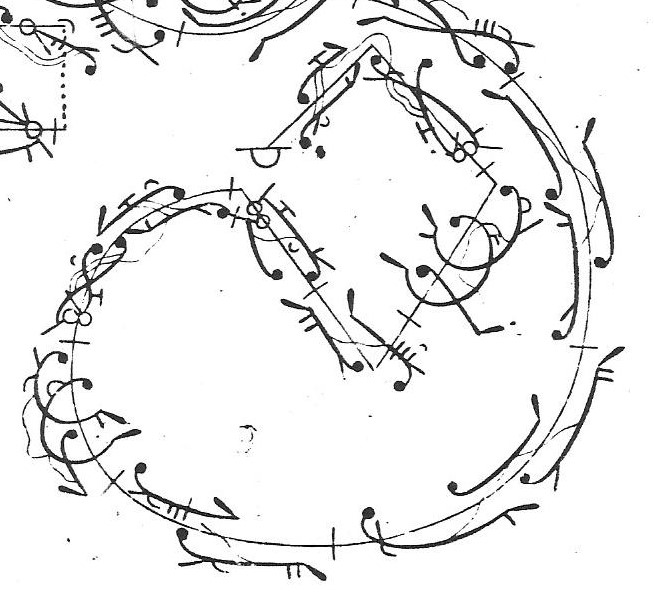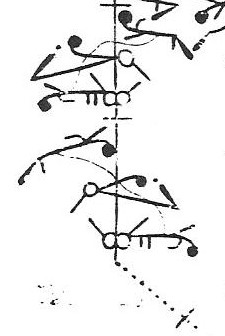The Spanheim, from Mr Isaac’s 1706 A Collection of Ball-Dances Perform’d at Court, was one dance I had never learnt until now. It took me while to settle into its steps and figures, but once I became more familiar with the choreography I really enjoyed working on it. I have already mentioned this duet in some of my other posts about Mr Isaac’s dances and these are listed at the end of this one.
The music for this choreography is a gigue (or perhaps an English ‘jigg’ – a point it would be interesting to be able to discuss further). It has the musical structure AABBCCDD played through twice (A=4 B=6 C=4 D=6) to give 80 bars of music and dancing. There has been some doubt about when the duet was created and danced at court. In her 1985 thesis, Carol Marsh suggested that it could be dated between 1701 and 1705, pointing out that the music appeared not only in The Second Book of the Lady’s Banquet, published in 1706, but was also used in 1705 for a country dance. The title is said to refer to Ezekial Spanheim (1629-1710), Prussian ambassador to the English court from 1702. However, the chance discovery of a reference to a court ball suggests that The Spanheim was first danced in 1703 and that it might well have been named after Spanheim’s daughter Mary Ann, then aged around twenty. The reference comes from a letter written by E. Hinde to Mary Foley and dated 20 February 1703, transcribed in an article by Rob Jordan ‘An Addendum to The London Stage 1660-1700’ (the full citation is given at the end of this post).
‘The Birth night was solemnised with much joy. ye Court very Splended. … The Lady Manchester a head & Ruffles £200: all lace – who with Madamosll Spanheim, were ye two principal Dancers. ye Latter Dancing a perticular one, wch none but ye person who was her parttener knew … The Queen stay’d till ½ a hour after 11 & ye Company Danc’d Countrey Dances till 4 in ye Morning.’
The reference to Mlle Spanheim’s dance supports the idea that this was The Spanheim, but who might her partner have been?
Isaac’s choreography for The Spanheim has two motifs in particular – paired steps and repeated sequences (the latter usually with an element of variation). I will look at some examples of these, which are also intertwined. The dance begins and ends in mirror symmetry, but the couple are in axial symmetry for most of the time. The figures are not entirely straightforward, at least on the page. The relative placing of the two dancers is sometimes misrepresented by the needs of the notation, for example making it uncertain whether they actually face each other up and down or across the dancing space. This is occasionally corrected between the plates (as with the end of the notation on plate 2 and the beginning on plate 3) but sometimes has to be inferred (as on plate 3 with the figure on a right line). John Weaver, the notator of the six dances, may still have been finding his way into this new skill. It is also worth noting here that around half of the steps in this dance incorporate jumps, so it is quite lively.
There are interesting sequences on every plate of The Spanheim, although I won’t try to look at them all. On plate 2, bars 21-28 (the first two C sections), there are the first of the glissades which Isaac interweaves throughout the dance. The first four steps are repeated for the second C, but with differences of alignment and variations in the steps themselves. Here is the man’s side (he is facing the presence as he begins).
Bars 29-34 on the same plate (to the first D section of the music) have a sequence which begins with a fleuret and a contretemps and ends with a contretemps and a fleuret. The third step is a quarter-turn pirouette, which perhaps provides a moment of suspension when the couple turn to look at each other as they pass on a circular path. Sadly, I do not have a dancing partner with whom to tease out the range of possibilities when reconstructing this section.
The repeat of the music begins on plate 3. Bars 41-48 (the repeat of the AA section) include a pas battu motif as well as three sets of paired steps. The most interesting of these are the two coupés battus in which the couple (facing each other on a right line, the man with his back to the presence) turn to right and then left, returning to face each other with an assemblé at the end of each step. Here are these steps on the man’s side, which is a bit clearer on my copy of the notation – I have changed the orientation of the page, for he has his back to the presence while the woman (further upstage) faces it.
The last sequence I would like to look at is on plate 4, bars 61-68 (the CC repeat). It uses pas balonnés (with demi-jettés rather than jettés), in a sequence with glissades and a fleuret. The two dancers are side-by-side holding inside hands and begin on the same foot. They move forwards towards the presence with pas balonnés, using the other steps to travel to left and right and right and left in turn. Here is the second half of this sequence. In which the lady is shown slightly behind the man to accommodate the notation on the page.
Isaac’s The Spanheim is full of echoes as it repeats and varies steps and motifs within the choreography and at different points in the music.
There is also a related piece of music ‘The New Spanheim’, published in 1710 by Walsh, Randall and Hare in For the Flute A Collection of all the Choicest French Dances Perform’d at Court the Theatres and Publick Balls. This collection of music was advertised in the Post Man for 22-25 April 1710, raising the possibility that Mr Isaac created a new choreography to celebrate the marriage of Mary Ann Spanheim to François de la Rochefoucauld, Marquis de Montandre in London on 21 April 1710. If he did, it was sadly not recorded in notation – so far as we know.
Other posts mentioning The Spanheim:
Mr Isaac’s Six Dances
Mr Isaac’s Choreography: The Six Dances – Opening and Closing Figures
Mr Isaac’s Choreography: The Six Dances – Motifs and Steps
References
Carol Marsh, ‘French Court Dance in England, 1706-1740: a Study of the Sources’ (unpublished PhD thesis, City University of New York, 1985)
Rob Jordan, ‘An Addendum to The London Stage 1660-1700’, Theatre Notebook, 47.2 (1993), 62-75 (p. 69), citing the ‘Morgan Collection 783/Box 24’ in the Shropshire Archives.




